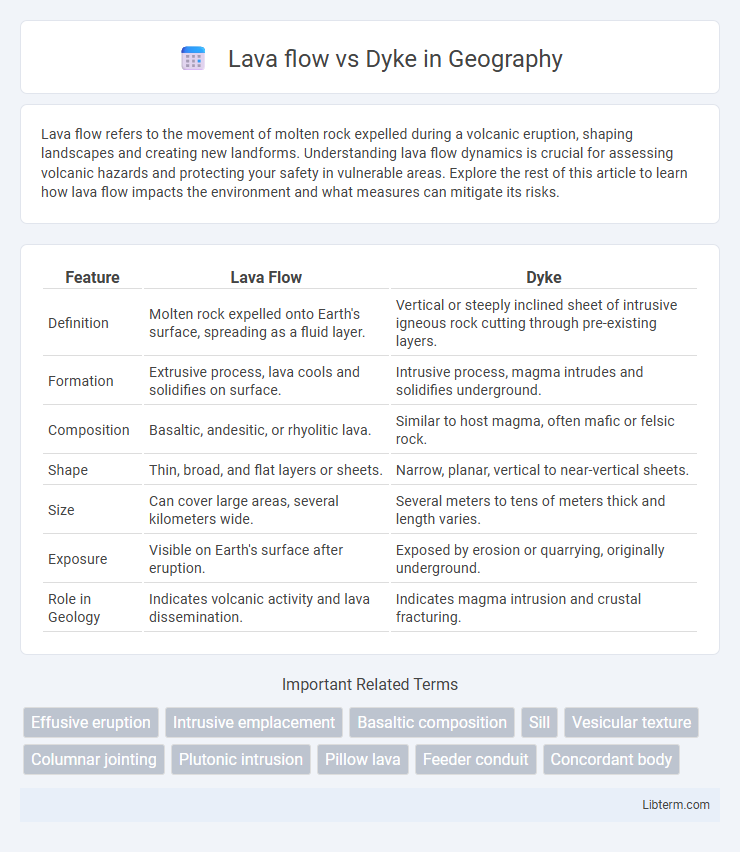Lava flow refers to the movement of molten rock expelled during a volcanic eruption, shaping landscapes and creating new landforms. Understanding lava flow dynamics is crucial for assessing volcanic hazards and protecting your safety in vulnerable areas. Explore the rest of this article to learn how lava flow impacts the environment and what measures can mitigate its risks.
Table of Comparison
| Feature | Lava Flow | Dyke |
|---|---|---|
| Definition | Molten rock expelled onto Earth's surface, spreading as a fluid layer. | Vertical or steeply inclined sheet of intrusive igneous rock cutting through pre-existing layers. |
| Formation | Extrusive process, lava cools and solidifies on surface. | Intrusive process, magma intrudes and solidifies underground. |
| Composition | Basaltic, andesitic, or rhyolitic lava. | Similar to host magma, often mafic or felsic rock. |
| Shape | Thin, broad, and flat layers or sheets. | Narrow, planar, vertical to near-vertical sheets. |
| Size | Can cover large areas, several kilometers wide. | Several meters to tens of meters thick and length varies. |
| Exposure | Visible on Earth's surface after eruption. | Exposed by erosion or quarrying, originally underground. |
| Role in Geology | Indicates volcanic activity and lava dissemination. | Indicates magma intrusion and crustal fracturing. |
Introduction to Lava Flows and Dykes
Lava flows are streams of molten rock expelled from volcanoes during eruptions, solidifying as they cool while moving across the Earth's surface. Dykes are vertical or steeply inclined sheets of magma that intrude into cracks and solidify underground, cutting across existing rock layers. Both features provide essential insights into volcanic activity, magma movement, and geological formations.
Formation Processes of Lava Flows
Lava flows form when molten rock erupts from a volcano and travels over the surface, cooling and solidifying as it moves away from the vent. The viscosity and temperature of the lava determine the flow's shape and speed, with low-viscosity basaltic lava creating broad, thin sheets and high-viscosity andesitic or rhyolitic lava forming thicker, slower-moving flows. In contrast, dykes form when magma intrudes into fractures beneath the Earth's surface, solidifying into vertical or steeply inclined sheets without reaching the surface.
Formation Processes of Dykes
Dykes form when magma intrudes into cracks and solidifies vertically or steeply through existing rock layers, cutting across pre-existing structures. This intrusive process differs from lava flows, which involve magma reaching the surface and spreading horizontally as molten rock. The formation of dykes often indicates subsurface magma movement and local stress fields causing fracturing of the host rock.
Differences in Physical Appearance
Lava flows typically appear as broad, smooth or ropy surfaces known as pahoehoe or rough, jagged textures called 'a'a, spreading horizontally across the landscape. Dykes form as vertical or near-vertical sheets of igneous rock cutting through pre-existing formations, often visible as linear, wall-like intrusions with sharp edges. While lava flows cover extensive ground and cool from the outside inward, dykes crystallize within fractures underground, leading to their distinct, narrow and tabular physical appearance.
Composition and Texture Comparison
Lava flows are predominantly composed of basaltic or andesitic magma with fine-grained, usually glassy textures due to rapid cooling on the surface. Dykes consist mainly of similar mafic to felsic compositions but exhibit coarser-grained, crystalline textures formed by slower cooling within subsurface fractures. The compositional variation between lava flows and dykes reflects differences in magma evolution and emplacement environments, influencing their mineralogy and textural characteristics.
Geological Settings of Lava Flows
Lava flows occur when molten rock extrudes onto the Earth's surface, typically in volcanic settings where magma reaches the surface through vents or fissures. These flows solidify as they cool, forming layered basaltic or rhyolitic rock deposits that characterize volcanic landscapes. In contrast, dykes are vertical or steeply inclined intrusions that cut through pre-existing rock layers, crystallizing beneath the surface and providing insights into subsurface magmatic processes and tectonic stress fields.
Geological Settings of Dykes
Dykes form when magma intrudes into fractures cutting across existing rock layers, solidifying to create vertical or steeply-inclined sheets that differ from the horizontal layering of lava flows. Geological settings for dykes often include tectonically active regions where crustal extension or faulting generates fractures, allowing magma to exploit these weaknesses. These intrusions provide critical evidence of subsurface magmatic plumbing systems and tectonic stress orientations within the Earth's crust.
Impacts on Landscape and Topography
Lava flows create broad, often gently sloping landforms by spreading molten rock over large areas, leading to the formation of extensive plateaus and shield volcanoes. Dykes, as vertical or steeply inclined intrusions cutting through pre-existing rock layers, produce linear ridges and cliffs that dissect the landscape. The contrasting emplacement styles result in lava flows smoothing topography, while dykes introduce sharp, elevated features influencing erosion patterns and drainage systems.
Role in Volcanic Eruptions and Hazards
Lava flows are molten rock that emerges from volcanic vents and travel across the surface, posing direct hazards like property destruction and wildfires. Dykes are vertical or steeply inclined intrusions that cut through pre-existing rock layers, controlling magma ascent and sometimes causing surface deformation or fractures. While lava flows impact surface environments, dykes play a crucial role in the subsurface plumbing system of volcanoes, influencing eruption style and likelihood.
Importance in Interpreting Earth’s History
Lava flows provide critical evidence of surface volcanic activity, revealing the eruption styles, temperatures, and chemical composition of magma that shaped the Earth's crust. Dykes, as vertical or steeply-inclined intrusions, record subsurface magma pathways and emplacement processes, offering insights into tectonic stress regimes and crustal fracturing. The comparative study of lava flows and dykes is essential for reconstructing volcanic plumbing systems and understanding the dynamic evolution of Earth's lithosphere over geological time.
Lava flow Infographic

 libterm.com
libterm.com